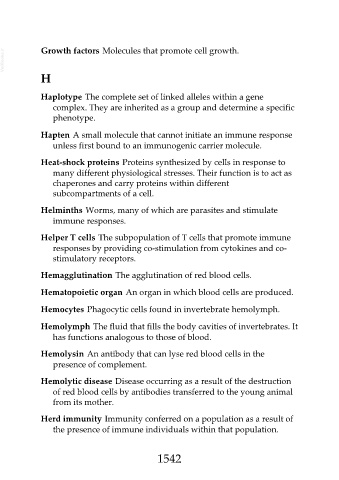Page 1542 - Veterinary Immunology, 10th Edition
P. 1542
VetBooks.ir Growth factors Molecules that promote cell growth.
H
Haplotype The complete set of linked alleles within a gene
complex. They are inherited as a group and determine a specific
phenotype.
Hapten A small molecule that cannot initiate an immune response
unless first bound to an immunogenic carrier molecule.
Heat-shock proteins Proteins synthesized by cells in response to
many different physiological stresses. Their function is to act as
chaperones and carry proteins within different
subcompartments of a cell.
Helminths Worms, many of which are parasites and stimulate
immune responses.
Helper T cells The subpopulation of T cells that promote immune
responses by providing co-stimulation from cytokines and co-
stimulatory receptors.
Hemagglutination The agglutination of red blood cells.
Hematopoietic organ An organ in which blood cells are produced.
Hemocytes Phagocytic cells found in invertebrate hemolymph.
Hemolymph The fluid that fills the body cavities of invertebrates. It
has functions analogous to those of blood.
Hemolysin An antibody that can lyse red blood cells in the
presence of complement.
Hemolytic disease Disease occurring as a result of the destruction
of red blood cells by antibodies transferred to the young animal
from its mother.
Herd immunity Immunity conferred on a population as a result of
the presence of immune individuals within that population.
1542

